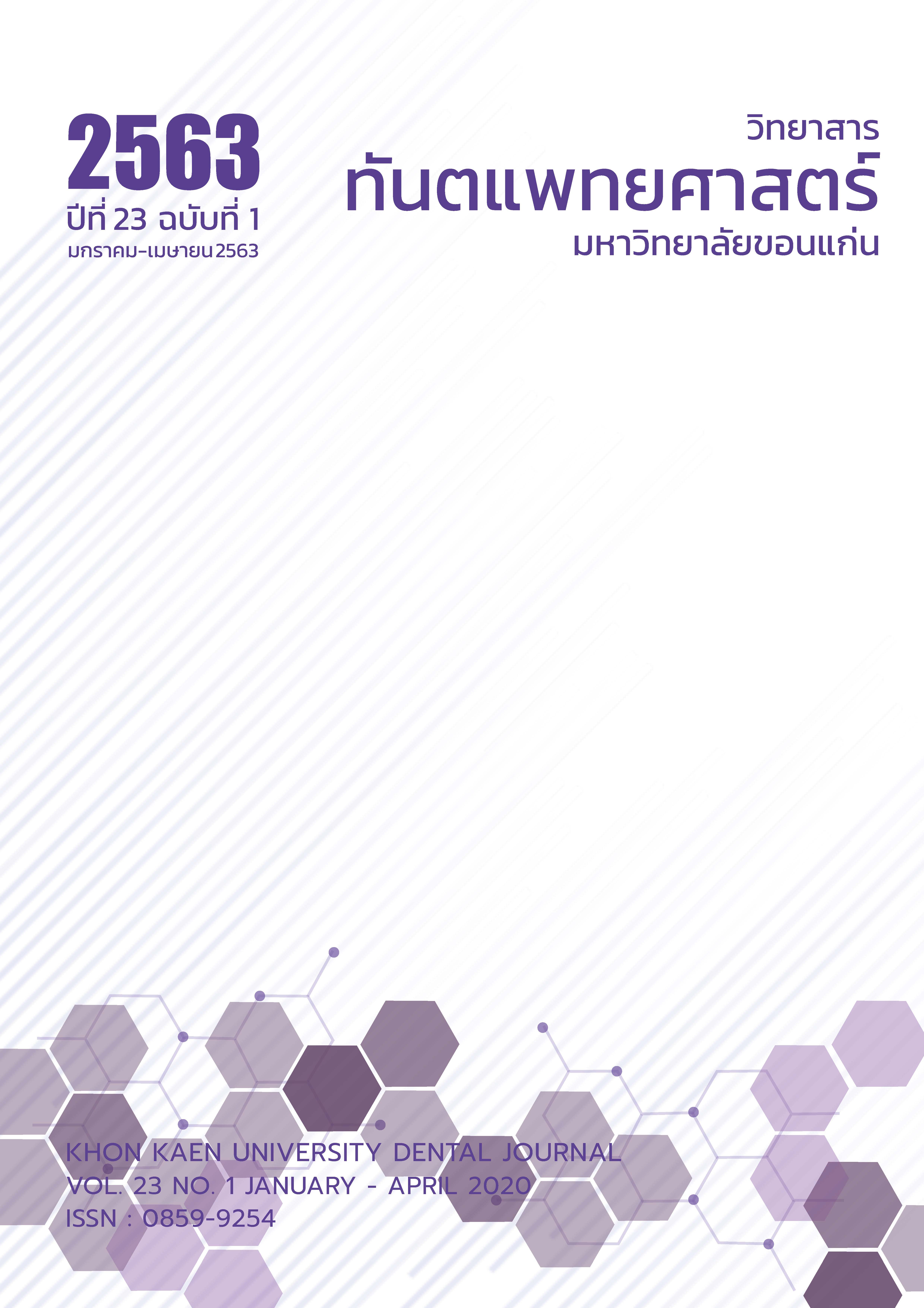Effects of Khon Kaen University Presurgical Nasoalveolar Molding Device on Maxillary Dimension in Complete Unilateral Cleft Lip and Palate Patients: A Full Protocol Evaluation
Main Article Content
Abstract
A prior study reported on maxillary dentoalveolar changes post-application of the full Khon Kaen University Pre-surgical Nasoalveolar Molding device (KKU-PNAM) in complete unilateral cleft lip and palate patients. However, since the KKU-PNAM consists of three separate components, the individual effect of each part is still unclear. The purpose of this study is to determine maxillary dimensional changes after using KKU-PNAM at three time points. The researcher investigated 24 maxillary ridge casts taken from infants with complete unilateral cleft lip and palate were investigated after treatment with the KKU-PNAM at initial treatment (T1), two weeks (T2) and before cheiloplasty (T3). Landmark identification and direct measurements including alveolar cleft width, anterior arch width, mid-palatal cleft width, posterior arch width, anterior arch depth, total arch depth, arch circumference and midline deviation were solely performed by one experienced investigator. Intra-examiner reliability was verified via intraclass correlation (ICC). All measurements were normally distributed, with data analyzed via repeated measure ANOVA. The results showed that the average pre-treatment and post-treatment ages were 16.33±17.36 and 123.21±32.76 days respectively, with mean total treatment time at 105.29±33.98 days. Alveolar cleft width and midline deviation significantly reduced over time from T1 to T3 (p<0.01). Furthermore, arch circumference gradually increased among T1, T2 and T3 (p<0.05). There was no significant difference in anterior arch width, mid-palatal cleft width, posterior arch width, anterior arch depth and total arch depth at T2 and T3 (p>0.05). In conclusion, the severity of alveolar cleft was reduced significantly after the KKU-PNAM was applied at the first two weeks, as the labial taping’s effect further decreased severity by addition of the contraction-screw plate until the point of primary lip surgery, thus improving the position of the maxillary alveolar ridge which brought out better outcomes prior to lip surgical correction.
Article Details
บทความ ข้อมูล เนื้อหา รูปภาพ ฯลฯ ที่ได้รับการลงตีพิมพ์ในวิทยาสารทันตแพทยศาสตร์ มหาวิทยาลัยขอนแก่นถือเป็นลิขสิทธิ์เฉพาะของคณะทันตแพทยศาสตร์ มหาวิทยาลัยขอนแก่น หากบุคคลหรือหน่วยงานใดต้องการนำทั้งหมดหรือส่วนหนึ่งส่วนใดไปเผยแพร่ต่อหรือเพื่อกระทำการใด ๆ จะต้องได้รับอนุญาตเป็นลายลักษณ์อักษร จากคณะทันตแพทยศาสตร์ มหาวิทยาลัยขอนแก่นก่อนเท่านั้น
References
Spengler AL, Chavarria C, Teichgraeber JF, Gateno J, Xia JJ. Presurgical nasoalveolar molding therapy for the treatment of bilateral cleft lip and palate: a preliminary study. Cleft Palate Craniofac J 2006;43(3):321-8.
Grayson BH, Santiago PE, Brecht LE, Cutting CB. Presurgical nasoalveolar molding in infants with cleft lip and palate. Cleft Palate Craniofac J 1999;36(6):486-98.
Manosudprasit M, Chongcharueyskul P. Presurgical Nasoalveolar Molding Techniques for a Complete Unilateral Cleft Lip and Palate Infant: A Case Report. J Med Assoc Thai 2015;98(7):S234-42.
Wongpetch R, Manosudprasit M, Pitiphat W, Manosudprasit A, Manosudprasit A. Dentoalveolar Changes after using nasoalveolar molding device in complete unilateral cleft lip and palate patients. J Med Assoc Thai 2017; 100(8):S117-22.
Prahl C, Kuijpers‐Jagtman AM, Van'T Hof MA, Prahl‐Andersen B. A randomised prospective clinical trial into the effect of infant orthopaedics on maxillary arch dimensions in unilateral cleft lip and palate (Dutchcleft). Eur J Oral Sci 2001;109(5):297-305.
Sabarinath V, Thombare P, Hazarey P, Radhakrishnan V, Agrekar S. Changes in maxillary alveolar morphology with nasoalveolar molding. J Clin Pediatr Dent 2010; 35(2):207-12.
Adali N, Mars M, Petrie A, Noar J, Sommerlad B. Presurgical orthopedics has no effect on archform in unilateral cleft lip and palate. Cleft Palate Craniofac J 2012;49(1):5-13.
Monasterio L, Ford A, Gutiérrez C, Tastets ME, García J. Comparative study of nasoalveolar molding methods: nasal elevator plus DynaCleft® versus NAM-Grayson in patients with complete unilateral cleft lip and palate. Cleft Palate Craniofac J 2013;50(5):548-54.
Abdiu A, Ohannessian P, Berggren A. The nasal alar elevator: A new device that may reduce the need for primary operation of the nose in patients with cleft lip. Scand J Plast Reconstr Surg Hand Surg 2009;43(2):71-4.
Doruk C, Kiliç B. Extraoral nasal molding in a newborn with unilateral cleft lip and palate: a case report. Cleft Palate Craniofac J 2005;42(6):699-702.
Smith KS, Henry BT, Scott MA. Presurgical dentofacial orthopedic management of the cleft patient. Oral Maxillofacial Surg Clin N Am 2016;28(2):169-76.
Awasthi P, Thahriani A, Bhattacharya A. Nasoalveolar morphology following presurgical orthopedic treatment in unilateral cleft lip alveolus and palate infants. Int J Dent Med Spec 2016;3(1):6-11.
Dawjee S, Julyan J, Krynauw J. Lip tape therapy in patients with a cleft lip-a report on eight cases: clinical communication. S Afr Dent J 2014;69(2):62-9.
Grayson BH, Shetye PR. Presurgical nasoalveolar moulding treatment in cleft lip and palate patients. Indian J of Plast Surg 2009;42(Suppl):S56-61.
Berggren A, editor Surgical tape and the nasal alar elevator—two simple and useful tools in the early preoperative treatment of cleft lip patients. International Congress of cleft lip-palate and craniofacial Anomalies; 2001.
Grayson BH, Maull D. Nasoalveolar molding for infants born with clefts of the lip, alveolus and palate. Clin Plast Surg 2004;31(2):451-8.
Manosudprasit M, Wangsrimongkol T, Pisek P, Wiwatworakul O. Pre-surgical nasoalveolar molding technique: a literature review. J Med Assoc Thai 2014; 97(10): S17-24.


